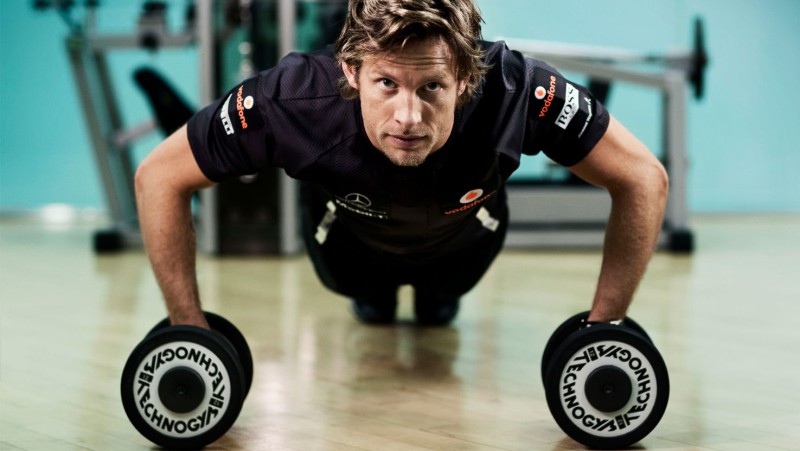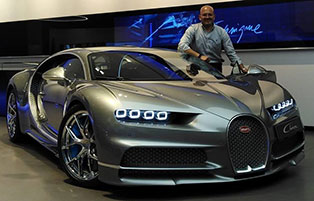
F1 2011
Are you fit enough to be a world-class racing driver? Part 3
In part 3 of our series, we will discuss one of the fundamental pillars of being a world-class racing driver, namely the fitness component.
Any driver, who decides to pursuit a professional Formula One career, needs to undergo a strict period of conditioning to endure the extreme physical demands of the sport, as no other race series in the world exploits the drivers in terms of stamina and endurance like Formula 1.
The vast acceleration, brake performance, cornering speeds, and grip levels that Formula One cars are capable of creating, e.g. up to a sustained 3.5 g of cornering force, indicate that the driver has to be enormously strong and fit to be able to last for full race distances, without showing any signs of weakness and muscular failure. In addition to this, as a racing driver gets tired, he/she tends to commit more mistakes.
This is another reason why being extremely fit is a vital component in F1 today. Last but least, one has to emphasis the fact, that a fit body needs less time to recover, possess a lung operating with higher oxygen uptake capacity than average Joe, and is less prone to a total collapse in case of crash. Rehabili
As a matter of fact, a lot of conventional workout programs designed by normal trainers try to endeavor fitness issues of physical strength related to endurance and stamina by combining running, swimming, cycling, hiking with pumping iron at the gym.
The low impact endurance training is aimed at preparing the body for 120 minutes of torturous driving. It must be mentioned here, that drivers generally alternate between running, rowing or cycling to avoid suffering from continuous yet monotonous and boring workouts. The runners cover about 10 miles per day , whereas cycling places less stress on the joints, as the weight is placed on the seat and without putting knee joints under unnecessary stress and impact, and therefore cyclists may cycle over 30 miles per day.
Many drivers prefer the exercise in the seated rowing position, as an example of non-weight bearing exercise. Swimming also works almost all muscles of the body without harming the joints of the body, while at the same time improving the fitness level, and reducing the heart rate of the person in question.
Unfortunately these traditional workout programs do not focus on the core muscles and other muscle groups the racing driver heavily utilizes in the cockpit to withstand the forces the body experiences during a complete race distance.
It must be mentioned here, that motorsport in general and Formula 1 in specific put tremendous loads of tearing g-forces on the head and neck of any racing driver.
Strength here is especially important, as the neck must support the weight of the driver's head in addition to the helmet under intense g-forces. 10 lbs (head and helmet) can be easily handled by an average person, when he or she is sitting in front of the TV.
Under racing conditions, neck, chest, and shoulder muscles experience unusual loads which cannot be easily simulated by traditional gym equipment. This leads to the fact, that many drivers use specially designed machines that enable them to specifically develop the muscles they will need to withstand these huge cornering forces.
This machine which has been developed specially for Formula 1 drivers, involves sitting in a cockpit-like structure and wearing a helmet attached to pulleys. The machine pulls at the neck from different angles, simulating the stresses when on track. It also allows racing drivers to work the stabilizing muscles of shoulders, thus resembling various forces and racing conditions trying to tear the body into pieces.
In addition to this, powerful arm muscles are also required to enable the car to be controlled during longer races.
All the above-mentioned become practically useless, if there is not a tailored core-training program accompanying the personalized endurance and strength training regimen.
Therefore it is of outmost importance to focus on a strong core in order to correctly perform strength training exercises, to lift a maximum amount of weight and to reduce the risk of injuries. These core and balance exercises look easy but are very demanding and a lot of people are surprised how difficult these are, when performed for the first time, and were never a crucial part of their fitness program.
The fitter a person becomes, the less effort the heart has to execute to pump blood in the arteries transporting oxygen from the lunges to the target organs e.g. brain and muscles. This can be seen by the fact that the resting heart rate of a top athlete is around 40 beats per minutes, whereas sedentary persons have a heart rate of approximately 80 beats per minute!
What a lot of Formula 1 enthusiasts do not know, is that former Formula 1 world champions like Ayrton Senna and Michael Schumacher were among the first drivers who took the fitness level of Formula 1 drivers to a new dimension.
When Michael Schumacher decided to return back to Formula 1 racing in 2010, a lot of skeptical people thought that he will not be fit enough when compared to his almost 20 years younger Formula 1 counterparts. Muscle memory and his continuous dedication to fitness- even when he was away from the racing scene-made his comeback much easier than expected, and impressed even the most pessimistic person.
For all those who after all this still doubt the fitness level of Formula 1 drivers, it must be mentioned here, that McLaren’s Jenson Button has put in an impressive performance at London Triathlon in 2010 when he finished third out of the 500-plus competitors in his group, with a time of 2.14:15.The annual event includes a 1500-metre swim, a 40-kilometre bike ride and a 10-kilometre run. It attracts 11,000 entrants making it the largest triathlon in the world.
He also participated in The Lavaman Triathalon at the Waikoloa resort on Big Island (Hawaii) where competitors complete a 1.5km swim, 40km bike race and a 10km run in a huge test of endurance in tropical temperatures. Jenson Button managed to finish this grueling race an impressive ninth out of 1,100 men.
In the vast Middle East region, outdoor conditions throughout the year (except winter) are very difficult and challenging when compared with the European weather conditions, which minimizes the possibilities to run, swim and cycle in Mother Nature. Hiking on the other hand, is also not a realistic option due to the absence of mountains in most of the Middle East countries.
Core, balance and flexibility training, on the other hand can easily be done indoors, and do not need a lot of equipment and vast space, but must be incorporated into any fitness/strength program, if the athlete in question aims to achieve professional status.
In part 4 of our series, we will shed light on the importance of nutrition and supplement intake, as any professional athlete seeking world class status needs an optimized tailored nutrition regimen to attain optimum performance.
Alhussein El Shennawy
13.11.2011
Related articles:
#SaferCarsForEgypt
 Want to sell your used car or buy one? Then check out our new used car market section
here!
Want to sell your used car or buy one? Then check out our new used car market section
here!
 Looking for a good service center or aftersales customer service? Did you have any bad experience with your car dealer or service center? Then check our 'automotive evaluation charts'
here!
Looking for a good service center or aftersales customer service? Did you have any bad experience with your car dealer or service center? Then check our 'automotive evaluation charts'
here!
Is Egyptian car market corrupt or collapsing?

Is the Egyptian car market collapsing or is it just a corrupt and unprofessional car market?
This is surely one of the most asked questions these days. Everybody is asking ...
AutoArabia Consulting
Middle East Car of the Year

Read more
Crash Test Results

Subscribe




 STYLING SPECIFICATION SHARPENS BENTLEY’S SPORTING EDGE
STYLING SPECIFICATION SHARPENS BENTLEY’S SPORTING EDGE Daniel Ricciardo joins Renault Sport Formula One Team ...
Daniel Ricciardo joins Renault Sport Formula One Team ... World debut for new McLaren 600LT at Goodwood Festival ...
World debut for new McLaren 600LT at Goodwood Festival ... McLAREN CONFIRMS ITS MOST TRACK-CONCENTRATED ROAD CAR YET
McLAREN CONFIRMS ITS MOST TRACK-CONCENTRATED ROAD CAR YET Lamborghini Urus SUV Paint Plant Confirmed at ...
Lamborghini Urus SUV Paint Plant Confirmed at ... Bugatti and Al Habtoor inaugurate brand’s largest ...
Bugatti and Al Habtoor inaugurate brand’s largest ... McLAREN AUTOMOTIVE LAUNCHES SIX-YEAR INVESTMENT ...
McLAREN AUTOMOTIVE LAUNCHES SIX-YEAR INVESTMENT ... PRODUCTION OF THE McLAREN P1™ COMES TO AN END
PRODUCTION OF THE McLAREN P1™ COMES TO AN END 2015 Dubai Motor Show: Mclaren launches special edition ...
2015 Dubai Motor Show: Mclaren launches special edition ... McLAREN CELEBRATES 50 YEARS OF HISTORIC US RACE SERIES ...
McLAREN CELEBRATES 50 YEARS OF HISTORIC US RACE SERIES ...




